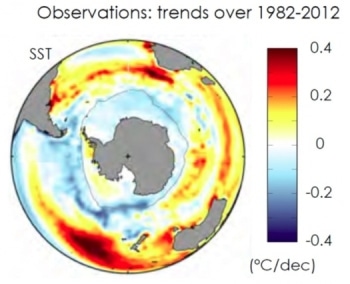Jun 27 2016
Around the world, scientists are observing evidence of climate change — record high temperatures, rising sea levels, and melting ice sheets.
 Observed sea surface temperature (SST) trends for 1982-2012 in degrees Celsius per decade. The blue areas around Antarctica correspond to cooling, and the red/yellow areas closer to the equator correspond to warming. (Credit- Image: Courtesy of the researchers)
Observed sea surface temperature (SST) trends for 1982-2012 in degrees Celsius per decade. The blue areas around Antarctica correspond to cooling, and the red/yellow areas closer to the equator correspond to warming. (Credit- Image: Courtesy of the researchers)
But new research from MIT’s Program in Atmospheres, Oceans and Climate indicates that Antarctica and the Southern Ocean may be experiencing a period of cooling before warming takes over — and the culprit might be the ozone hole rather than greenhouse gases.
“Our study tries to address one of the most mysterious problems of recent historical climate change in the region because, in contrast to the strong global warming trend, we’ve seen persistent cooling in the Southern Ocean and sea ice expansion,” says Yavor Kostov PhD '16, a recent MIT graduate and lead author on the study published in the journal Climate Dynamics. “And our study addresses some mechanisms that could be related to this persistent cooling trend.”
Kostov, along with oceanographer John Marshall, the Cecil and Ida Green Professor in MIT’s Department of Earth, Atmospheric and Planetary Sciences (EAPS) and colleagues, used results from computer simulations with models called coupled general circulation models (CGM) and observations to better understand how the ocean, atmosphere, and ice interact together, which could lead sea surface temperatures to fall and sea-ice to expand round Antarctica.
He attributes this to a combination of circumstances unique to the Southern Ocean encircling Antarctica: “The Southern Ocean is a very special place,” Kostov says. Without a continental barrier in the way, the winds and water can flow relatively unobstructed in a generally eastward direction around Antarctica. And unlike other parts of the world’s oceans, salinity — not temperature — governs the stratification of the Southern Ocean, so layers of cold relatively fresh water float atop warmer saltier water. Moreover, the Antarctic is a region with significant ozone depletion, primarily due to chlorofluorocarbon (CFC) emissions. Ozone depletion in the stratosphere far above the Earth’s surface can “modify the pattern of atmospheric circulation all the way down to the ocean’s surface, and this change in the westerly winds then alters the way the ocean circulates. And we study exactly the effect of this change in the [Southern] Ocean circulation,” Kostov says.
Kostov and Marshall argue that sea surface temperatures and sea-ice around Antarctica initially cool and expand, respectively, in response to ozone-related changes in surface wind trends. This is because the strengthening of the westerly winds drives cold water equator-ward away from the Antarctica, encouraging sea-ice growth. However, on longer timescales, warm water is drawn up from below resulting in warming of sea surface temperatures and sea-ice decline. However, not all models transition from a period of surface water cooling and sea-ice expansion to warming and sea-ice loss.
What, then, is the mechanism that sets the crossover timescale from cooling to warming?
“Our paper suggests that the first process — the northward transport of colder water — dominates this fast cooling response, but then over longer time scales, we have this build-up of heat below the surface that impacts the slow timescale of response — the gradual warming,” Kostov says. As the winds force cold freshwater away from the Antarctic pole, warm saltwater underneath rises to replace it. “This is a slower mechanism because this temperature inversion — cold overlying warm water — is below this well-mixed surface there of the ocean, which changes its depth seasonally,” he continued. Each winter this mixed layer reaches deeper and takes up some of the heat which builds up because of anomalous upwelling. Eddies deep within the ocean may also interfere with the upwelling of warm water, contributing to the slow warming response seen in some of the models.
The takeaway is that we’ve identified a fundamental mechanism that allows the Southern Ocean to respond to the change in westerly winds, with initial cooling, but then we show that this might be followed by gradual warming. And we relate this fundamental response to its climatological temperature gradients. So one message is: It’s important that models have the right Southern Ocean climatology to be able to get this response to this shift in the winds.
In a world that is increasingly feeling the effects of global warming, Kostov remarks that this new research can help improve climate science and inform policy. Understanding the climate mechanisms at play in the Southern Ocean can not only explain observances of cooling there, but also why the Southern Ocean is able to absorb heat from the atmosphere and how it transports this heat northward where it can be stored deeper in the ocean. This is particularly important since over 90 percent of the world’s heat from human influences is stored in the World Ocean with a major contribution from the Southern Ocean, and this in turn affects the pace of global warming. Additionally, cooling around Antarctica is often contrasted against global warming, but studies like MIT’s help to explain that Southern Ocean cooling is one part of a larger evolving picture in the Earth’s climatological record. Kostov says that their study provides yet another scientific stepping-stone towards understanding the fundamentals surrounding Antarctic climate and ocean behaviors.
Source: http://web.mit.edu/